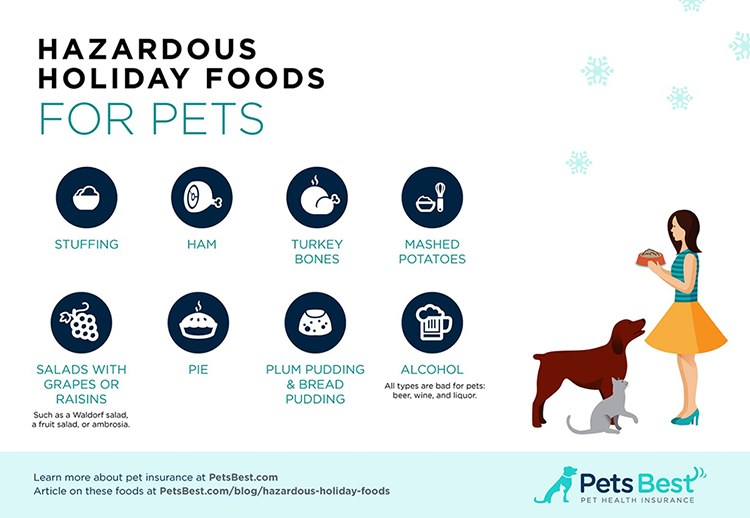Six Holiday Foods to Keep Away From Your Pets
Learn why the following six foods can be dangerous for dogs and cats.
-
Stuffing
Thanksgiving dressing is often made with onions, scallions or garlic. These ingredients, however, are extremely toxic to dogs and cats and can cause a life-threatening anemia (destruction of the red blood cells). It’s best to avoid feeding any amount of stuffing to pets.
-
Ham
Ham and other pork products can cause pancreatitis, upset stomach, vomiting and diarrhea. Pork tends to be high in fat as well, which can lead to obesity in pets. Even a small amount of ham can contribute a very large amount of calories in a small dog or cat.
-
Turkey Bones
Bones can cause severe indigestion in dogs and cats, potentially causing vomiting and obstructing the bowel. Bones may also splinter and cause damage to the inside of the stomach and intestines. In some cases, turkey bones may even puncture through the stomach and cause a potentially fatal abdominal infection.
-
Mashed Potatoes
While potatoes are safe for pets to eat, mashed potatoes usually contain butter and milk, which can cause diarrhea in lactose intolerant pets. Additionally, some recipes call for onion powder or garlic, which are very toxic to pets.
-
Salads with Grapes/Raisins
There are many salads served during the holidays that include grapes or raisins as an ingredient, from fruit salad, to waldorf salad, to ambrosia. However, grapes and raisins are very toxic and potentially deadly. Grapes can cause severe, irreversible and sometimes fatal kidney failure in dogs. Be sure to keep all dishes that include grapes and raisins away from pets.
-
Chocolate Desserts
While pumpkin pie is the most famous Thanksgiving dessert and canned pumpkin has pet health benefits, many people offer a variety of chocolate desserts at Thanksgiving and throughout the holidays. Chocolate is toxic to dogs and cats, yet dogs love the smell and taste of it. The darker the chocolate, the more toxic it is. Keep all chocolate desserts out of the reach of pets to prevent an emergency trip to the veterinarian.
If your pets ingest any of these foods this holiday season, be sure to call your veterinarian immediately. Unexpected veterinary visits can be expensive but that’s where pet insurance can help, by reimbursing on veterinary bills.
Have a happy and safe holiday season!
Learn more about the
Union Plus Pet Insurance Member Benefit,
powered by Pets Best

The holidays are almost here and that means an abundance of delicious food. However, many popular human dishes aren’t healthy for pets to consume. This is important to remember during holiday meals, when dogs and cats beg for table scraps and guests might fall for those cute faces.
Is Your Home Underinsured?
Improvements Can Boost Home Value
Home improvement projects do more than increase your comfort and pleasure—they can spike the cost to rebuild your home.
How to fix it: Once a year, do a policy review with your MetLife Auto & Home insurance representative. He or she can calculate how much it would cost to rebuild your house, then make sure your insurance policy covers you for 100 percent of that estimated amount.
Higher Construction Costs Aren’t Factored In
Even if your home was properly insured when you purchased it from a builder, today’s higher costs of construction and changes in building codes could cause problems should you need to rebuild.
How to fix it: Ask for a total component rebuilding estimate that evaluates each aspect of your home’s construction. This includes examining the quality of materials — flooring, cabinets, vanities and countertops — rather than merely applying known rates of inflation to your former insurance limits.
Older Homes Have Unique Characteristics
Older homes, especially if they are historic, present unique insurance challenges.
Potential problems: Older homes often feature better craftsmanship and higher-quality materials than those used in contemporary homes. Details, such as high-grade wood floors or an elaborately detailed Victorian exterior, can be much more expensive to replace than modern vinyl tile and siding.

L0717496846[exp0620][All States][DC]

Two out of three U.S. homes don’t have enough coverage in case of disaster. Find out if yours is one of them.
Two Summer Water-Related Hazards for Pets
Water Safety
Although many canines are strong swimmers, they should always be closely supervised and wear life jackets when their owners take them for a summer swim.
Pet owners with pools should pay close attention to outdoor cats and dogs when they’re playing near the pool in case they accidentally fall in.
“For dog owners with pools, I always suggest training their dogs to find the shallow end of the pool or the stairs so they can exit the pool safely. This is important regardless of whether you plan to let your dogs swim in the pool. I recall a claim we processed for BooBoo, an English bulldog, who was found unconscious on the pool floor; but thankfully he recovered after an emergency visit to the veterinarian,” said Dr. Stephens, founder of Pets Best. “Even dogs that are good swimmers or wearing life jackets can tire quickly and be put in danger if they can’t find their way out of the pool.”
A few other bodies of water hazards pet owners should be aware of include:
-
Exposure to Leptospira, a potentially deadly pathogen found within some lakes and ponds.
-
Fishhooks, which can get stuck in paws if stepped on, stuck in mouths, or even swallowed.
-
Boats, they can accidentally hit dogs who are swimming in lakes.
Ear Infections
Ear infections are one of the top five most common dog insurance claims we process at Pets Best. Ear infections are an especially common summertime ailment among dogs that swim frequently. These infections are often caused by water entering dogs’ ears while swimming. Pet owners can help prevent this by utilizing an ear cleanser prescribed by a veterinarian to clean and dry a dog’s ears after swimming.
We hope you and your pets enjoy safe and healthy water adventures this summer.


Playing in the water is a great way to cool off for both humans and our pets. But when it comes to dogs and cats, water can present some health issues and hazards as well. Keep your pets safe with these tips from Pets Best, the nationwide dog and cat health insurance agency that powers the Union Plus Pet Health Insurance program.
It’s Take Your Pet to the Office Day!
Every day is “Take Your Pet to Work Day” at Pets Best Pet Health Insurance, who powers the Union Plus Pet Health Insurance program. Meet some of their furry family members who have helped Pets Best to become a five time “Best Places to Work” winner, and customer rated 9.6 out of 10. Since 2005, they’ve been taking care of their customers’ pets with the same love they give their own. Learn more about the Union Plus Pet Health Insurance program.
How Much Homeowner’s Insurance Do I Need?
What’s Under Your Policy’s Hood?
So your homeowner’s policy is very likely to cover a bit more than just your home. Therefore, it’s important to understand exactly what’s covered and for how much. Most policies typically offer the following types of coverage:
- Dwelling
- Other structures
- Personal possessions
- Loss of use
- Personal liability
- Medical payments
Dwelling – More than Just Your Mortgage
One common mistake homeowners often make is to only get enough insurance coverage to cover the cost of their mortgage. Your mortgage, however, does not represent the actual value of your home, or the cost to replace the home as is. Ultimately, what you want is enough insurance to completely rebuild your home in a worst case scenario. Your best bet would be to hire a builder to assess your house and provide an estimate for current replacement costs. Insurance agencies also sell “guaranteed replacement cost” insurance, which – as the title implies – guarantees that you’d be covered for the full cost of replacement, but those policies are costly and hard to come by.
Alternately, you can get “extended replacement coverage”, which in most cases means the insurer will pay out up to 125 percent of your policy limit towards rebuilding your home. Some insurers offer an “inflation guarantee”, which increases to cover changing costs over time. Otherwise, you’d be wise to routinely review your dwelling coverage against the actual cost to replace – materials and services are likely to increase in cost over time, meaning total replacement may require a higher policy limit.
Special Circumstances
Depending on where you live and what hazards your house faces, you may need to purchase additional types of coverage. The most common type of supplemental insurance is flood insurance. In many locations, flood insurance may actually be required by your lender before closing on a mortgage.
Unfortunately, the reason flood insurance exists is because most regular homeowner’s policies don’t cover damages related to flooding. If you’re unsure about whether or not you need flood insurance, you can visit FloodSmart.gov, which is the National Flood Insurance Program’s website.
Other Structures and Personal Possessions
Coverage for “other structures” generally refers to unattached buildings (like a shed) or fences on your property. As with dwelling coverage, ideally you should have a policy limit high enough to fully replace these structures should they be destroyed.
Personal possessions, as a category, can be a little trickier. A popular rule of thumb is to insure your possessions for about 50 to 75 percent of your dwelling coverage, and then purchase additional coverage for any possessions of exceptional value (like expensive pieces of jewelry). If you’d like to be a little more accurate, you can use an app or a program like KnowYourStuff to create a complete catalog of all of your possessions.
Loss of Use, Personal Liability, and Medical Payments
Loss of use coverage represents money that would be available to you if you were temporarily displaced from your home and needed to stay somewhere else. It’s a bit like the rental car coverage you may have included in your car insurance.
Personal liability and medical payment coverage are there to protect you in the event someone is hurt or injured on your property. Medical payment coverage specifically covers medical bills for you or anyone else who suffers an injury on your property, while personal liability kicks in if you’re sued for injuries or damages occurring on your property.
Without adequate personal liability coverage, your savings and other accumulated assets could be at risk if an incident occurs. It’s hard to know exactly how much personal liability coverage is the right amount, but you should definitely consider the relative risk factors (Do you have a swimming pool? Is your home more than one floor? Etc.) when deciding on an amount.
Your Deductible
Finally, while homeowner’s insurance is expensive to have, it’s also expensive to use. Like most forms of insurance, if the cost of a repair is low enough to handle out-of-pocket, it’s usually in your best interests to do so. That’s why it’s often preferable to choose a policy with a high deductible, since a higher deductible usually means a lower premium, which can represent a significant savings over time. It’s a good idea to earmark a portion of your savings for out-of-pocket repairs or covering your deductible so you’ll be prepared if something goes wrong.
Need a little more help? MMI offers homebuyer education courses for anyone looking to buy a new home. Whether you're a first-time homebuyer looking to learn the basics or current owner in need of an education certificate for a specialized loan program, these online courses are thorough, informative, and easy-to-use.


Homeownership! The American Dream! And quite likely a very good dream in every other country where they have houses. It’s a big step and an expensive one, too. Among the many costs you may not be considering if you’ve never owned a home, homeowner’s insurance can be a significant chunk of your budget. But exactly how much homeowner’s insurance do you need? And what does it mean to over or under-insure your home?
What Does Pet Insurance Cover and What’s the Cost?
Pets Best Has Three Types of Plans
- BestBenefit Accident and Illness Plan
- Accident-Only Plan
- Wellness Routine Care Plan
What Does Each Plan Cover?
- BestBenefit Accident and Illness Plan
This is the most popular and comprehensive plan offering coverage for accidents and illnesses. Examples of accidents include a broken bone, laceration, and eating a toy or sock. Examples of illnesses include cancer, allergies, ear infections, and diabetes. - Accident-Only Plan
This budget-friendly plan has coverage for accidents only. It does not cover illnesses. - Wellness Routine Care Plan
Wellness routine care plans cover include coverage for items such as vaccinations, teeth cleaning, and flea & tick prevention. This can be added on to either of the above two plans.
What’s Not Covered?
No pet insurance company covers pre-existing conditions. But, if your pet has a pre-existing condition (for example allergies) there are still thousands of other future health issues that pet insurance covers. Additionally, it’s not liability insurance and it’s not life insurance for pets.
How Much Does Pet Insurance Cost?
- BestBenefit Accident and Illness Plan
The cost is based on the pet’s age, breed and location. So you have to get a quote to see how much a plan will cost. However, a common monthly price range is $30-$65. - Accident-Only Plan
This is a flat rate plan. It only costs $6 per month for cats and $9 per month for dogs. - Wellness Routine Care
Plan Pets Best offers two routine care plans. The EssentialWellness plan is $16 per month and the BestWellness plan is $26 per month. (The price only varies in Washington state where EssentialWellness is $14 per month and the BestWellness is $30 per month).

Pet health insurance reimburses pet owners on veterinary bills when their dog or cat gets sick or injured. Simple, right? It can be, but learning about the specific types of pet insurance plans will help you make a better coverage decision for your furry loved ones.


What Is Pet Insurance and How Does It Work?
What is Pet Insurance?
Pet health insurance reimburses pet owners on veterinary bills when their pet gets sick or injured. Pets Best also offers a routine care plan (for vaccinations, flea and tick preventatives, and more).
Dogs and cats of any breed can be enrolled in a pet insurance plan starting at 7 weeks old, up to any age. Pets Best plans are available in all 50 states & D.C.
Why Do Pet Parents Need It?
- 1 in 3 pets will have an unexpected veterinary visit this year.1
- Veterinary care is more sophisticated than ever, therefore costs have gone up (pets can have MRIs, chemo, etc.).
- For peace of mind.2 So you can go back to enjoying your pet, rather than worrying about what might happen & the cost.
Here’s How Pet Insurance Works, In 4 Easy Steps
- Get an Instant Quote & Sign Up
Get a pet insurance quote for your pet(s) in three minutes or less. You can enroll immediately if you’d like. You don’t need your pet’s medical records to enroll and Pets Best offers a 30- day money back guarantee.
- Get Treatment
When your pet becomes ill or injured, take them to the veterinarian.
- File a Claim
Pay your veterinarian, and then submit the claim to Pets Best.
- Get Reimbursed
Pets Best processes most claims within 5 days, then reimburses you on that veterinary bill. You can add your direct deposit account information for free, so you’ll get your money back even faster.

1. From Datamonitor.
2. From 2016 NAPHIA survey of pet insurance customers

If you are a pet parent, you want to keep your furry friend (and your wallet) protected in case of an emergency. Educate yourself on how pet insurance works with this explanation from Pets Best.

How To Know If You Need Flood Insurance
It’s a good idea to think about flood insurance in advance of an event, because standard homeowners policies exclude flood coverage. You can find out whether your property is in a low-, moderate- or high-risk flood area by entering your address into the Federal Emergency Management Agency (FEMA) database. Keep in mind, however, that 25 percent of all flood claims are from people who don’t live in high-risk areas. And because of the recent boom in new housing developments, the land’s natural runoff pattern might have changed from what a 10-year-old flood map shows.
MetLife Auto & Home is proud to offer our customers flood insurance through the National Flood Insurance Program (NFIP) and Federal Emergency Management Agency (FEMA), and it covers more than just the structure of your home. It also covers debris removal, damage to your contents and more. Contact your local MetLife Auto & Home representative or call one of our flood specialists toll free at 855-666-5797.
L0915436452[exp0917][All States][DC]

MetLife Auto & Home offers flood policies through the National Flood Insurance Program (NFIP) and Federal Emergency Management Agency (FEMA), covering your home’s structure and any debris removal necessary.
Your Golden Years: 5 Steps to a Happy, Healthy Retirement
Here are five steps to take now, while you’re still working:
- Schedule your annual checkups and recommended screenings.
Regular screening can help you avoid health problems in retirement. Early detection can identify health problems at the onset — and either eliminate them or make them more manageable. Talk to your doctor about recommended screenings, based on your age and health history. - Eat healthy and exercise.
Staying active and eating right as you age reduces your risk of many chronic diseases. And it can improve your mood and boost your energy. Focus on eating nutrient-dense foods such as vegetables, fruits, legumes and whole grains. Limit your intake of saturated fats, added sugars and sodium. If you haven’t exercised in awhile, schedule your physical before your begin. - Choose your health care providers.
Take the time to find health care providers with whom you feel comfortable. Select a primary care physician, specialist for any existing conditions or special needs, an urgent care provider, and a full service hospital. Ask your friends and relatives for recommendations. Then see if the physicians and facilities you select will accept the insurance you’ll have when you retire. Planning up front lets you control the quality of care you receive — and manage you costs. - Understand your health insurance options.
Health care in retirement is expensive — even with Medicare and private insurance. A study by Fidelity Investments estimates a 65-year old couple will need $240,000 to cover their out-of-pocket health care costs if they spend 20 years in retirement.
Take the time to understand how Medicare works. Medicare covers a lot of your expenses, but it doesn’t cover them all. So in addition to the cost of your Medicare coverage, you’ll probably want to purchase supplement insurance to fill in the gaps.
If you plan to retire before age 65, you’ll need to look for health insurance outside of Medicare. You may be able to continue your current employer coverage under COBRA. If married, switching to your spouse’s plan may be an option. Or you could purchase a policy on your own through your local broker on the healthcare exchange. - Don’t wait to replace your life insurance.
Once you stop working, it’s likely you’ll lose the life insurance benefits your employer provides. The longer you wait to replace them, the more difficult it may be — especially if you develop health problems. The cash payment life insurance provides can help your family get by without your financial support or help a child you love with the cost of a good education. It can help a spouse offset Social Security and pension payments that reduce at the death of a husband or wife.
Originally published by Good Sam Life and Health Solutions.
When retirement is on the horizon, most Americans think about getting their finances in order. But while in the planning stages, it’s important to assess your health, as well. The investment you make in your health today will make your retirement more enjoyable — and save you money in the process.
Estate Planning: You Can't Ignore Life Insurance
Here are a Few Reasons to Consider Life Insurance:
- Estate Taxes
Many consider life insurance as an estate planning tool. Benefits can be used to pay estate taxes rather than selling assets. If your liquid assets aren't enough to pay your estate taxes, consider purchasing a life insurance policy to cover them. Federal Estate taxes kick in for estates above $2 million. - Final Expenses
Some people buy a small life insurance policy, just to cover their final expenses. Funeral costs alone average now more than $8,300, according to the National Funeral Directors Association. And you may leave some medical expenses not covered by health insurance. - Pension Replacement
Many traditional pension plans pay benefits that are based on the life of the participant only. So when that participant dies, the surviving spouse no longer collects pension payments. Consider, too, that Social Security benefits will reduce at the death of a spouse. - Outstanding Debts
For married retirees, having enough coverage to pay off large debts, such as a mortgage balance, can ensure the surviving spouse can stay in the home they love. - Gift for a Loved One or Charity
Life insurance is a way to leave a legacy for a special person or charity. If you intend to leave a small sum of cash to either, consider using that cash to purchase a much larger amount of life insurance instead. Take the amount you plan to leave and use it to pay premiums. This could result in a much more generous gift over their lifetime. - Dependent Children
If you had children later in life or have a child with special needs, ongoing support or medical care may become costly and last many years. If you have children who will be attending college, consider life insurance to help with tuition. In 2014, average public in-state academic institution tuition was $9,913, while out-of-state tuition was $22,958. Average private college tuition was a whopping $31,231.* - Still Working?
If you continue to work after retirement – and your family relies on your income – consider life insurance for income replacement. Make sure your dependents are able to stay afloat financially without your salary.
If it makes sense to make life insurance part of your overall retirement strategy, it makes sense to purchase coverage now. The younger you are, the less it will cost and the less likely you are to be turned down for purchase due to health conditions.
Learn More
*The College Board, Trends in College Pricing (2014)
Originally published by Good Sam Life and Health Solutions.
Many people buy life insurance when their families are young and their financial responsibilities are at their highest. But as you get older, even at retirement, life insurance can be a very valuable addition to your financial plan.